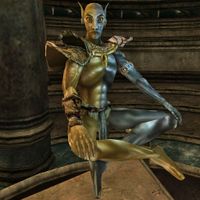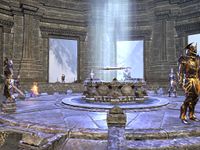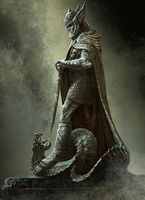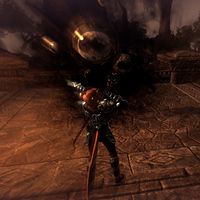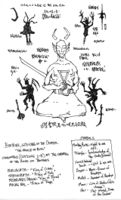Lore:CHIM
—Commentaries on the Mysterium Xarxes, Book Three
CHIM (/tʃɪm/[1] or /kim/[UOL 1]) has been described as the secret syllable of royalty,[2] and can be considered a form of Apotheosis.[3][UOL 2] The state of CHIM allows for transcendence and freedom from all known laws and mortal limitations of Convention created by the Aedra, as well as the corruptions of the black sea of Oblivion.[UOL 2] This state of being is considered similar to the divine power the Gods had prior to Convention, during the Dawn Era.[3][4][5][UOL 2][UOL 3] This is also described as returning to a state of pure Aurbis, the possibility brought by the collision between Anu and Padomay.[UOL 2] However it is free of the disaster that troubled the Gods, as during the Dawn Era, the physical make-up of the mortal plane and it's linear chronology of time became unstable as they walked.[6][UOL 2]
CHIM is capitalized because it is from the Ehlnofex language, the language of the Ehlnofey who are believed to have been the progenitors of the modern races.[6][7][UOL 2] It is an ancient sigil connoting 'royalty', 'starlight', and 'high splendor'. The actual form of the Sigil in Ehlnofex script is described as resembling a "Crowned Tower", and so the proper written form of CHIM would be the syllable "I"[8][UOL 4]
Understanding CHIM[edit]
—36 Lessons of Vivec, Sermon 1
Attaining CHIM is a process of reaching an understanding about the truth of the nature of the universe and one's place in it, leading to a simultaneous comprehension of the full scope of existence, at risk of losing ones individuality.[9][UOL 2] This truth is referred to as the "Secret Syllable" that the "Secret Triangular Gate" hides. The "Secret Triangular Gate" is said to be hidden within "The Center" of the Tower, which metaphorically refers to both Nirn and its Heart. This Triangle is the very same "Tri-Angled Truth" that Boethiah showed the Chimer alongside Mephala and Azura. This process of attaining such a revelation became known as the Psijic Endeavor.[10][8][11]
The Tri-Angled Truth[edit]
—36 Lessons of Vivec, Sermon 21
The Aurbis is often depicted in the form of the Wheel. Turned on its side, it can be viewed as a Tower.[12][8] At the center of the Wheel of Aurbis, lies a smaller circle, Mundus, or "Nirn", which is considered the heart of all creation. The Secret, when viewed from the side, is revealed to be a Tower as well. This is known as the "I", or the "Secret Tower". The White-Gold Tower and all others are built to emulate this "Tower" depiction of the Aurbis.[8][UOL 2] Mundus is a reflection of the Wheel as a whole, being its hub (The Center). Mortals, living within this 'hub', are able to perceive the Tower within Mundus without leaving the 'Wheel'.
The significance of the Secret Tower is this: "I" is the only name of God (as a wheel, observed from the side, resembles an "I"). Realizing that God not only makes up the entirety of existence, but that God alone is the only being that truly exists, is the first half of attaining CHIM - the second half is a mortal, through great force of will, maintaining that they exist in spite of that.[8] The nature of this revelation has its basis in the nature of "God". Within the context of texts related to CHIM, "God" refers to Anu the Everything, whom is also known as the Godhead.[13][14][UOL 1] Given the understanding Anu encompasses and is all things,[14] the logical conclusion is each and every individual is Anu, and that no distinct individuality can be maintained in the face of this. By refusing this conclusion, and instead maintaining their continued existence, mortals are able to free themselves of the laws and logic of Convention.[UOL 1] If one comes to this understanding yet fails to maintain their own individuality, they "zero sum" and are erased from existence from that point forward.[15][16][UOL 5]
According to Vivec, the first to understand the concept was Lorkhan, whose curiosity and desire for change drove him to the rim of the Wheel and beyond, where he looked back at the Aurbis sideways and first witnessed the Tower.[UOL 2] Lorkhan then convinced the Aedra to join him in building Mundus, at the hub of the Wheel, in a venture to help others come to this realization.[6][17][18][19][UOL 2] Sources from the ancient Khajiit, such as the writings of Amun-Dro, claim Molag Bal and Boethra learned the secrets of "dark fire", from Lorkhaj.[20] Vivec has also described attaining CHIM as taking on the "Sacred/Secret Flame", which is also how Vivec describes Boethiah.[9][3]
Consequences of CHIM[edit]
—36 Lessons of Vivec, Sermon 11
The process of attaining CHIM is said to be one of great suffering and violence. Vivec likens the Truth of the Secret Tower to his rape by Molag Bal (whom he learned CHIM from in the first place).[15][8][9] CHIM is described to be akin to one freed from the drumming torment of an open wound, wherein they are "no longer an Anvil hammered by the Truth, but are now the Hammer" themselves.[21][22] His scripture also claims CHIM is alike to having "Black Hands", the process of attaining the state being akin to the nature of Mephala (and Anu). That being, murdering a "Double".[9][13] During the apocryphal events of his trial, he is said to have described his Hands as being burnt black by "Pure Aurbis", the moment the Exact-Cracking occurred.[UOL 6] According to some sources, "Exact-[Egg]-Cracking" (also referred to as "the Striking") refers to Sithis, more specifically, the exact moment Sithis sundered Anu, allowing the possibilities of the Aurbis.[23][24]
According to some sources, the state of CHIM is not permanent and must be retained - albeit at great risk to one's self.[UOL 1] A core trait of CHIM is that one can not recognize any equal or double, as CHIM is beyond duplexity.[25][UOL 2]
Uses of CHIM[edit]
—36 Lessons of Vivec, Sermon 15
Vivec had written extensively on CHIM, having claimed to have learned the concept from Molag Bal.[2] He claimed he only learned CHIM in order to advise the Nerevarine on how to wield it with "GHARTOK PADHOME", which is Ehlnofex for "Weapon-Hand Change", so that the Nerevarine could use this power in order to unmake Dagoth Ur.[26][2][27] Vivec also expected the Nerevarine to replace their role as spiritual Guide to Morrowind, as they could not lay true claim to CHIM if they recognized a double.[25][27][UOL 2]
Mankar Camoran claimed that the Tower touches all Mantles of Heaven. Thus through CHIM, attainment of the Tower, one may mantle any deity.[15] It has been claimed Talos in particular mantled Lorkhan via CHIM.[UOL 7][UOL 1] According to several sources, such as the writings of Mankar Camoran[15] and the teachings of Talos cultists,[28][UOL 8] the Emperor Tiber Septim utilized the divine state of CHIM in order to reshape the landscape of Cyrodiil from a jungle into more temperate forests and rolling grasslands.
The "Secret Syllable" of CHIM is said to be merely one way to "attain the Tower" - that is, to achieve divinity. The Walking Ways are six interrelated paths to achieving divinity, of which CHIM is merely the fourth.[3][9][21][UOL 2] All paths seem to require some understanding of the Wheel, the structure of the Aurbis.[15][8]
Ending of the Words[edit]
—36 Lessons of Vivec, Sermon 37
The ultimate goal of the Walking Ways is not solely achieving the Tower, but rather a process that comes after.[UOL 2]
Lorkhan is believed to have attempted this but failed, though why it failed has been the subject of intense disagreement and bloodshed from the dawn of creation to the present day.[17][19][14][29][30][11][31][UOL 2] Some attribute the failure to a mistake, others to Lorkhan's malice; the circumstances are unknown, but Vivec seemed to suspect that the so-called failure only occurred so that others might know how not to fail.[17][19][14][UOL 2]
The supposed state beyond CHIM, and the primary purpose of CHIM and all other Walking Ways,[UOL 1][UOL 2] known as Amaranth,[32][UOL 1] is said to involve mantling the Godhead and dreaming in the same way as Anu, the previous Amaranth, leading to an Exodus from the existing Aurbis.[32][33][UOL 1][UOL 2] This is said to be the ultimate goal of the Psijic Endeavor, as attaining the Tower as CHIM entails is merely the first step.[UOL 2] It is suggested this process should be not be done alone, lest you repeat the mistakes of those before you.[32][UOL 1] Further, in order to attain Amaranth, one must cut off the Black Hands that represent CHIM in the first place.[34][32][UOL 3][UOL 1]
—36 Lessons of Vivec, Sermon 37
Gallery[edit]
Notes[edit]
- "Chim" appears in "Chim-el Adabal", another name for the Red Diamond, which is the centerpiece of the Amulet of Kings. In this context, it presumably connotes royalty, though it might also refer to the splendor of the Red Diamond and possibly the Starlight it might have symbolised to the Ayleids as a soul gem.[citation needed]
- In a response to a question about The Elder Scrolls franchise being "all a dream", former Bethesda developer Michael Kirkbride said that treating the universe as simply somebody's dream was missing the point. He likened achieving CHIM to lucid dreaming. Kirkbride said to "consider your lucid dreams", and called CHIM "Divine Hypnagogia".[UOL 1] Lucid dreaming is when somebody realizes they are in a dream, and is commonly related with the ability to control the dream in some way. Hypnagogia is described as the transitional state between wakefulness and sleep, during which lucid dreams may occur. This is also how Vivec describes his divinity to the Nerevarine.[35]
See Also[edit]
Books[edit]
- The 36 Lessons of Vivec by Vivec — Words of wisdom relating to Vivec
- The Monomyth — A theological book containing the common creation myths
- Mythic Dawn Commentaries by Mankar Camoran — The series of books read by initiates to the Mythic Dawn cult
- Spirit of Nirn, God of Mortals — Opinions of the god Lorkhan and the origin of creation
References[edit]
- ^ Bardic songs in ESO
- ^ a b c 36 Lessons of Vivec, Sermon 12 — Vivec
- ^ a b c d 36 Lessons of Vivec, Sermon 6 — Vivec
- ^ 36 Lessons of Vivec, Sermon 18 — Vivec
- ^ Where Were You ... Dragon Broke — Various
- ^ a b c Before the Ages of Man — Aicantar of Shimerene
- ^ The Annotated Anuad
- ^ a b c d e f g 36 Lessons of Vivec, Sermon 21 — Vivec
- ^ a b c d e 36 Lessons of Vivec, Sermon 31 — Vivec
- ^ From Exile to Exodus — Tarvyn Aram
- ^ a b The Changed Ones
- ^ On the Detachment of the Sheath — Arch-Prelate Fervidius Tharn
- ^ a b 36 Lessons of Vivec, Sermon 35 — Vivec
- ^ a b c d The Monomyth
- ^ a b c d e Mythic Dawn Commentaries — Mankar Camoran
- ^ The Four Suitors of Benitah — Jole Yolivess
- ^ a b c Spirit of Nirn, God of Mortals
- ^ Plan to Defeat Dagoth Ur — Vivec
- ^ a b c Words of Clan Mother Ahnissi — Clan Mother Ahnissi
- ^ The Bladesongs of Boethra — Modun-Ra, the Hidden Voice
- ^ a b 36 Lessons of Vivec, Sermon 32 — Vivec
- ^ 36 Lessons of Vivec, Sermon 36 — Vivec
- ^ Sithis
- ^ French translation of The Monomyth
- ^ a b 36 Lessons of Vivec, Sermon 13 — Vivec
- ^ 36 Lessons of Vivec, Sermon 7 — Vivec
- ^ a b 36 Lessons of Vivec, Sermon 15 — Vivec
- ^ Heimskr's dialogue in Skyrim
- ^ The Great War — Legate Justianus Quintius
- ^ The Talos Mistake — Leonora Venatus
- ^ The Anticipations — Anonymous
- ^ a b c d 36 Lessons of Vivec, Sermon 37 — Vivec
- ^ Black Book: Waking Dreams — Bilius Felcrex
- ^ 36 Lessons of Vivec, Sermon 11 — Vivec
- ^ Vivec's dialogue in Morrowind
Note: The following references are considered to be unofficial sources. They are included to round off this article and may not be authoritative or conclusive.
- ^ a b c d e f g h i j k Michael Kirkbride's Posts
- ^ a b c d e f g h i j k l m n o p q r s The Thief Goes to Cyrodiil — Vivec
- ^ a b Michael Kirkbride's posts in The Trial of Vivec
- ^ More on the Psijic Endeavor — Vivec
- ^ Et'Ada, Eight Aedra, Eat the Dreamer — Michael Kirkbride
- ^ Michael Kirkbride's posts in The Trial of Vivec
- ^ Nu-Hatta of the Sphinxmoth Inquiry Tree
- ^ From The Many-Headed Talos
| ||||||||||||||||||||||||||||
| |||||||||||||||||||||||


